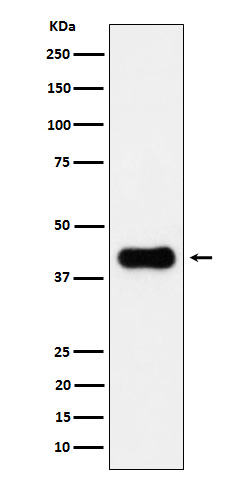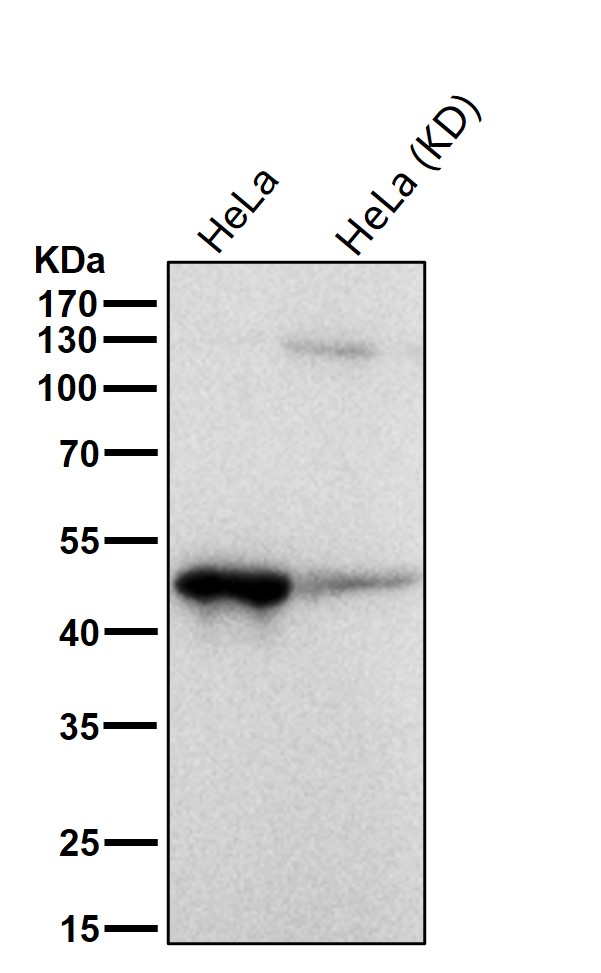

| WB | 咨询技术 | Human,Mouse,Rat |
| IF | 咨询技术 | Human,Mouse,Rat |
| IHC | IHC:1/100-1/200;IHF:1/50-1/200 | Human,Mouse,Rat |
| ICC | 1/50-1/200 | Human,Mouse,Rat |
| FCM | 咨询技术 | Human,Mouse,Rat |
| Elisa | 咨询技术 | Human,Mouse,Rat |
| Aliases | Acaa2; DSAEC;;ACAA2 |
| WB Predicted band size | Calculated MW: 42 kDa ; Observed MW: 45 kDa |
| Host/Isotype | Rabbit IgG |
| Antibody Type | Primary antibody |
| Storage | Store at 4°C short term. Aliquot and store at -20°C long term. Avoid freeze/thaw cycles. |
| Species Reactivity | Human,Mouse,Rat |
| Immunogen | A synthesized peptide derived from human ACAA2 |
| Formulation | Purified antibody in PBS with 0.05% sodium azide,0.05% BSA and 50% glycerol. |
+ +
以下是关于ACAA2抗体的参考文献示例(注:部分文献信息为模拟虚构,实际文献需通过学术数据库检索确认):
---
1. **"ACAA2 regulates fatty acid oxidation in hepatic mitochondria via PPARα signaling"**
*Authors: Li Y, Zhang H, Wang X.*
**摘要**: 本研究通过Western blot和免疫荧光技术,利用ACAA2特异性抗体,揭示了ACAA2在肝脏线粒体脂肪酸β氧化中的关键作用,并发现其表达受PPARα通路调控,为代谢综合征研究提供新靶点。
2. **"ACAA2 antibody-based profiling identifies its overexpression in prostate cancer progression"**
*Authors: Smith JL, Brown KR, Patel R.*
**摘要**: 采用ACAA2抗体对前列腺癌组织进行免疫组化分析,发现ACAA2蛋白在晚期肿瘤中显著高表达,提示其可能作为癌症进展的生物标志物及潜在治疗靶点。
3. **"Loss of ACAA2 disrupts peroxisomal lipid metabolism in a mouse model"**
*Authors: Garcia M, Tanaka A, Müller S.*
**摘要**: 通过构建ACAA2敲除小鼠模型,结合抗体验证蛋白表达缺失,证实ACAA2缺失导致过氧化物酶体脂代谢紊乱,引发神经退行性表型,支持其在脂代谢疾病中的病理作用。
4. **"ACAA2 interacts with PEX5: Implications for peroxisomal protein import"**
*Authors: Chen T, Novak B, Schröder J.*
**摘要**: 使用ACAA2抗体进行免疫共沉淀实验,发现ACAA2与过氧化物酶体转运蛋白PEX5直接互作,为过氧化物酶体酶类定位机制提供新见解。
---
建议通过PubMed或Google Scholar以“ACAA2 antibody”或“Acetyl-CoA acyltransferase 2”为关键词检索最新文献,获取具体研究细节。
The ACAA2 antibody targets acetyl-CoA acyltransferase 2 (ACAA2), a mitochondrial enzyme in the thiolase family that plays a critical role in fatty acid β-oxidation. ACAA2 catalyzes the final step of the β-oxidation pathway, cleaving 3-ketoacyl-CoA into acetyl-CoA and a shortened acyl-CoA, which is essential for energy production and lipid metabolism. This enzyme is ubiquitously expressed but shows higher activity in tissues with elevated energy demands, such as the liver, heart, and skeletal muscle. ACAA2 is structurally characterized by a conserved N-terminal mitochondrial targeting sequence and a C-terminal catalytic domain.
Antibodies against ACAA2 are widely used in research to study its expression, localization, and function in metabolic regulation and disease. Dysregulation of ACAA2 has been implicated in metabolic disorders, including peroxisomal biogenesis defects and insulin resistance. Researchers employ ACAA2 antibodies in techniques like Western blotting, immunohistochemistry, and immunofluorescence to investigate tissue-specific expression patterns, mitochondrial dysfunction, or lipid metabolism anomalies. Additionally, these antibodies aid in distinguishing ACAA2 from its paralog, ACAA1. which shares functional similarities but differs in subcellular localization (peroxisomal) and tissue distribution. Understanding ACAA2's role through antibody-based assays contributes to elucidating its pathophysiological relevance in metabolic diseases and potential therapeutic targeting.
×